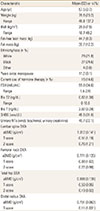1. Robbins J, Schott AM, Azari R, et al. Body mass index is not a good predictor of bone density: results from WHI, CHS, and EPIDOS. J Clin Densitom. 2006; 9:329–334.

2. Kim SJ, Yang WG, Cho E, et al. Relationship between weight, body mass index and bone mineral density of lumbar spine in women. J Bone Metab. 2012; 19:95–102.

3. Méndez JP, Rojano-Mejia D, Pedraza J, et al. Bone mineral density in postmenopausal Mexican-Mestizo women with normal body mass index, overweight, or obesity. Menopause. 2013; 20:568–572.

4. Gnudi S, Sitta E, Fiumi N. Relationship between body composition and bone mineral density in women with and without osteoporosis: relative contribution of lean and fat mass. J Bone Miner Metab. 2007; 25:326–332.

5. Liu S, Li J, Sheng Z, et al. Relationship between body composition and age, menopause and its effects on bone mineral density at segmental regions in Central Southern Chinese postmenopausal elderly women with and without osteoporosis. Arch Gerontol Geriatr. 2011; 53:e192–e197.

6. Ijuin M, Douchi T, Matsuo T, et al. Difference in the effects of body composition on bone mineral density between pre- and postmenopausal women. Maturitas. 2002; 43:239–244.

7. Howe TE, Shea B, Dawson LJ, et al. Exercise for preventing and treating osteoporosis in postmenopausal women. Cochrane Database Syst Rev. 2011; CD000333.

8. Kerr D, Morton A, Dick I, et al. Exercise effects on bone mass in postmenopausal women are site-specific and load-dependent. J Bone Miner Res. 1996; 11:218–225.

9. Rideout CA, McKay HA, Barr SI. Self-reported lifetime physical activity and areal bone mineral density in healthy postmenopausal women: the importance of teenage activity. Calcif Tissue Int. 2006; 79:214–222.

10. Geinoz G, Rapin CH, Rizzoli R, et al. Relationship between bone mineral density and dietary intakes in the elderly. Osteoporos Int. 1993; 3:242–248.

11. Khosla S, Melton LJ, 3rd , Atkinson EJ, et al. Relationship of serum sex steroid levels and bone turnover markers with bone mineral density in men and women: a key role for bioavailable estrogen. J Clin Endocrinol Metab. 1998; 83:2266–2274.

12. Gourlay ML, Preisser JS, Hammett-Stabler CA, et al. Follicle-stimulating hormone and bioavailable estradiol are less important than weight and race in determining bone density in younger postmenopausal women. Osteoporos Int. 2011; 22:2699–2708.

13. Gourlay ML, Specker BL, Li C, et al. Follicle-stimulating hormone is independently associated with lean mass but not BMD in younger postmenopausal women. Bone. 2012; 50:311–316.

14. Zehnacker CH, Bemis-Dougherty A. Effect of weighted exercises on bone mineral density in post menopausal women. A systematic review. J Geriatr Phys Ther. 2007; 30:79–88.

15. Snow-Harter C, Bouxsein M, Lewis B, et al. Muscle strength as a predictor of bone mineral density in young women. J Bone Miner Res. 1990; 5:589–595.

16. Douchi T, Matsuo T, Uto H, et al. Lean body mass and bone mineral density in physically exercising postmenopausal women. Maturitas. 2003; 45:185–190.

17. Reid IR, Ames R, Evans MC, et al. Determinants of total body and regional bone mineral density in normal postmenopausal women-a key role for fat mass. J Clin Endocrinol Metab. 1992; 75:45–51.

18. Mithal A, Bonjour JP, Boonen S, et al. Impact of nutrition on muscle mass, strength, and performance in older adults. Osteoporos Int. 2013; 24:1555–1566.

19. Villareal DT, Chode S, Parimi N, et al. Weight loss, exercise, or both and physical function in obese older adults. N Engl J Med. 2011; 364:1218–1229.

20. Coin A, Sergi G, Benincà P, et al. Bone mineral density and body composition in underweight and normal elderly subjects. Osteoporos Int. 2000; 11:1043–1050.

21. National Center for Health Statistics. Plan and operation of the Third National Health and Nutrition Examination Survey, 1988-94. Series 1: programs and collection procedures. Vital Health Stat 1. 1994; 32:1–407.
23. Centers for Disease Control and Prevention, National Center for Chronic Disease Prevention and Health Promotion. Behavioral risk factor surveillance system (BRFSS): 2005 survey questions. 2005. cited by December 22. Available from:
http://www.cdc.gov/brfss/questionnaires.htm.
24. Macera CA, Ham SA, Jones DA, et al. Limitations on the use of a single screening question to measure sedentary behavior. Am J Public Health. 2001; 91:2010–2012.

25. The Study of Osteoporotic Fractures (SOF). Study collection forms 2003: visit 1, lifestyle, physical activity and exercise. 2003. cited by 2013 December 22. Available from:
http://sof.ucsf.edu/Interface/DataDoc.asp.
27. Block G, Woods M, Potosky A, et al. Validation of a self-administered diet history questionnaire using multiple diet records. J Clin Epidemiol. 1990; 43:1327–1335.

28. StataCorp. Stata Statistical Software: Release SE 13.1. 2013. cited by 2013 December 22. Available from:
http://www.stata.com/.
29. Bland JM, Altman DG. Multiple significance tests: the Bonferroni method. BMJ. 1995; 310:170.
30. Hsu YH, Venners SA, Terwedow HA, et al. Relation of body composition, fat mass, and serum lipids to osteoporotic fractures and bone mineral density in Chinese men and women. Am J Clin Nutr. 2006; 83:146–154.

31. Rossouw JE, Anderson GL, Prentice RL, et al. Risks and benefits of estrogen plus progestin in healthy postmenopausal women: principal results From the Women's Health Initiative randomized controlled trial. JAMA. 2002; 288:321–333.

32. Anderson GL, Limacher M, Assaf AR, et al. Effects of conjugated equine estrogen in postmenopausal women with hysterectomy: the Women's Health Initiative randomized controlled trial. JAMA. 2004; 291:1701–1712.

33. Banks E, Beral V, Reeves G, et al. Fracture incidence in relation to the pattern of use of hormone therapy in postmenopausal women. JAMA. 2004; 291:2212–2220.

34. Trémollieres FA, Pouilles JM, Ribot C. Withdrawal of hormone replacement therapy is associated with significant vertebral bone loss in postmenopausal women. Osteoporos Int. 2001; 12:385–390.

35. Cauley JA, Robbins J, Chen Z, et al. Effects of estrogen plus progestin on risk of fracture and bone mineral density: the Women's Health Initiative randomized trial. JAMA. 2003; 290:1729–1738.

36. Earnshaw SA, Worley A, Hosking DJ. The Nottingham Early Postmenopausal Intervention Cohort (EPIC) Study Group. Current diet does not relate to bone mineral density after the menopause. Br J Nutr. 1997; 78:65–72.







 PDF
PDF ePub
ePub Citation
Citation Print
Print




 XML Download
XML Download